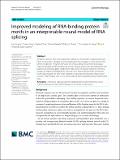Improved modeling of RNA-binding protein motifs in an interpretable neural model of RNA splicing
Author(s)
Gupta, Kavi; Yang, Chenxi; McCue, Kayla; Bastani, Osbert; Sharp, Phillip A.; Burge, Christopher B.; Solar-Lezama, Armando; ... Show more Show less
Download13059_2023_Article_3162.pdf (5.331Mb)
Publisher with Creative Commons License
Publisher with Creative Commons License
Creative Commons Attribution
Terms of use
Metadata
Show full item recordAbstract
Sequence-specific RNA-binding proteins (RBPs) play central roles in splicing decisions. Here, we describe a modular splicing architecture that leverages in vitro-derived RNA affinity models for 79 human RBPs and the annotated human genome to produce improved models of RBP binding and activity. Binding and activity are modeled by separate Motif and Aggregator components that can be mixed and matched, enforcing sparsity to improve interpretability. Training a new Adjusted Motif (AM) architecture on the splicing task not only yields better splicing predictions but also improves prediction of RBP-binding sites in vivo and of splicing activity, assessed using independent data.
Date issued
2024-01-16Department
Massachusetts Institute of Technology. Department of Electrical Engineering and Computer Science; Massachusetts Institute of Technology. Department of Biology; Koch Institute for Integrative Cancer Research at MITJournal
Genome Biology
Publisher
BioMed Central
Citation
Genome Biology. 2024 Jan 16;25(1):23
Version: Final published version